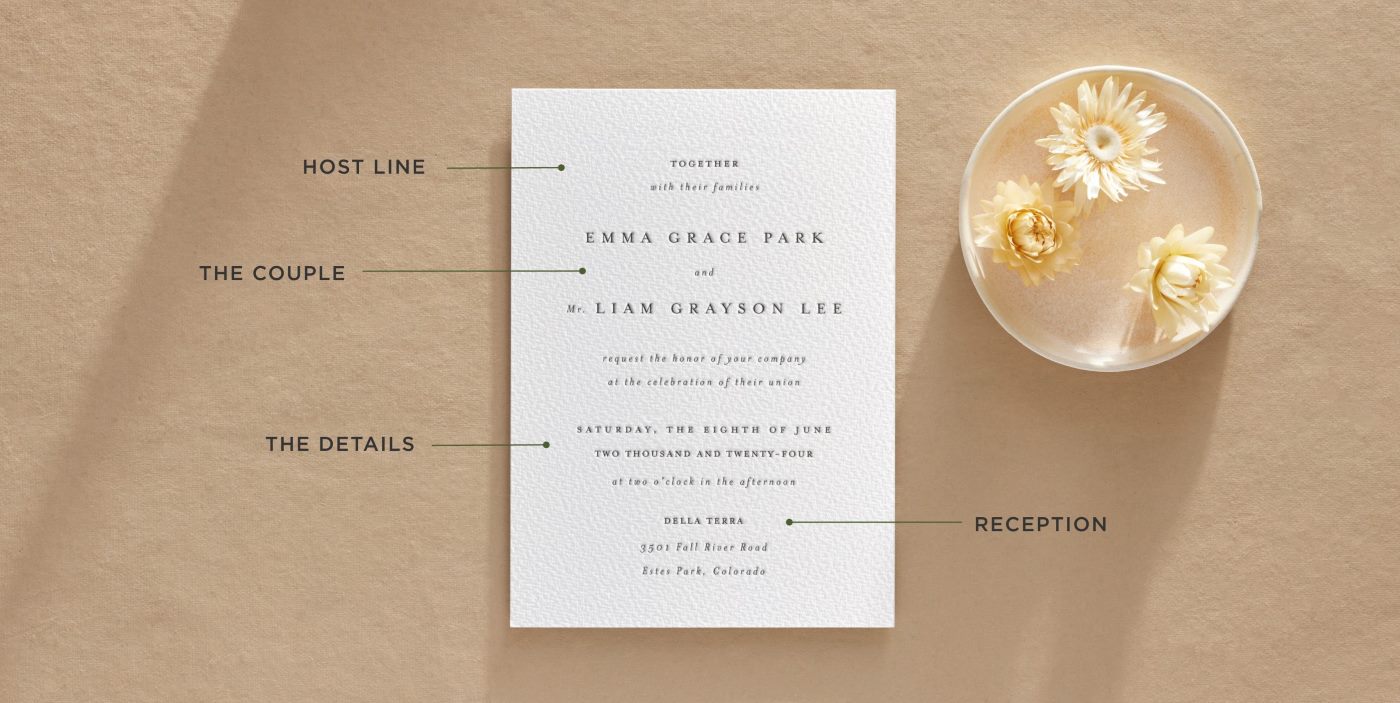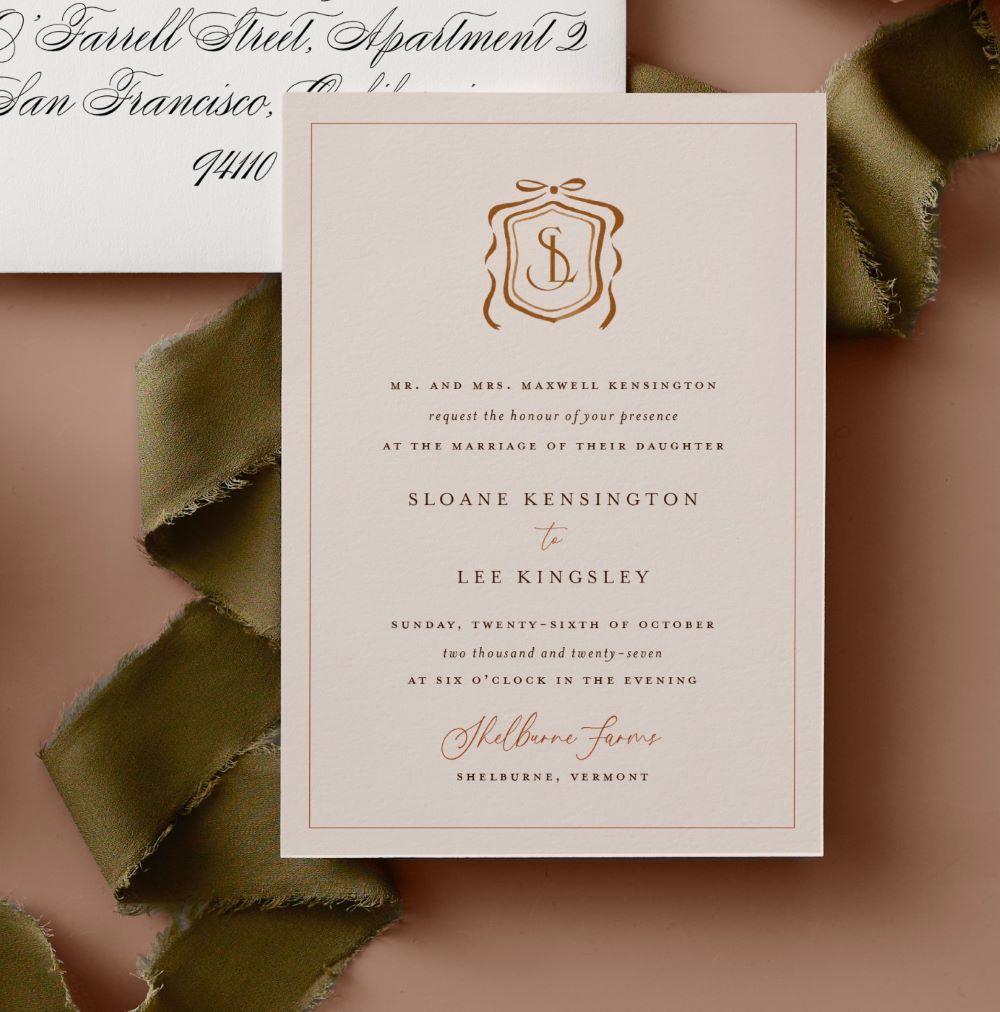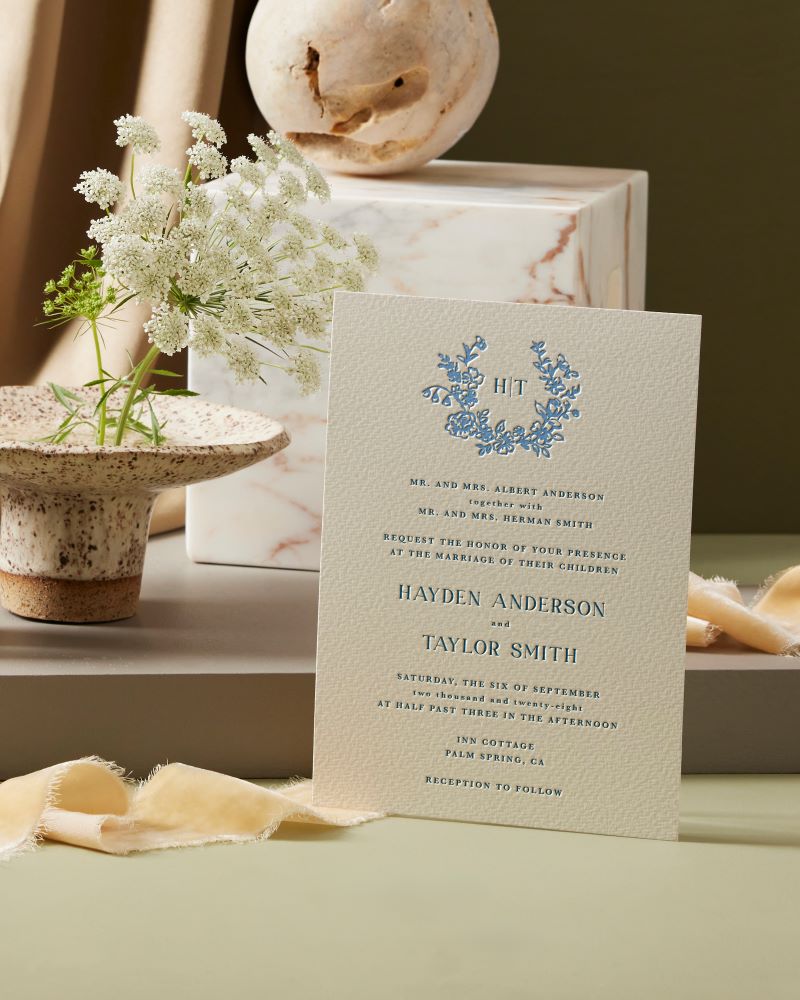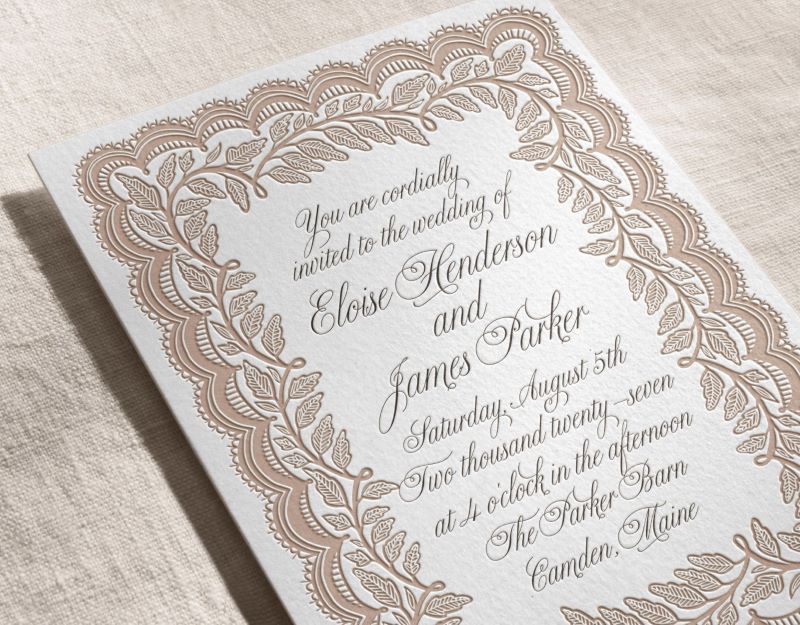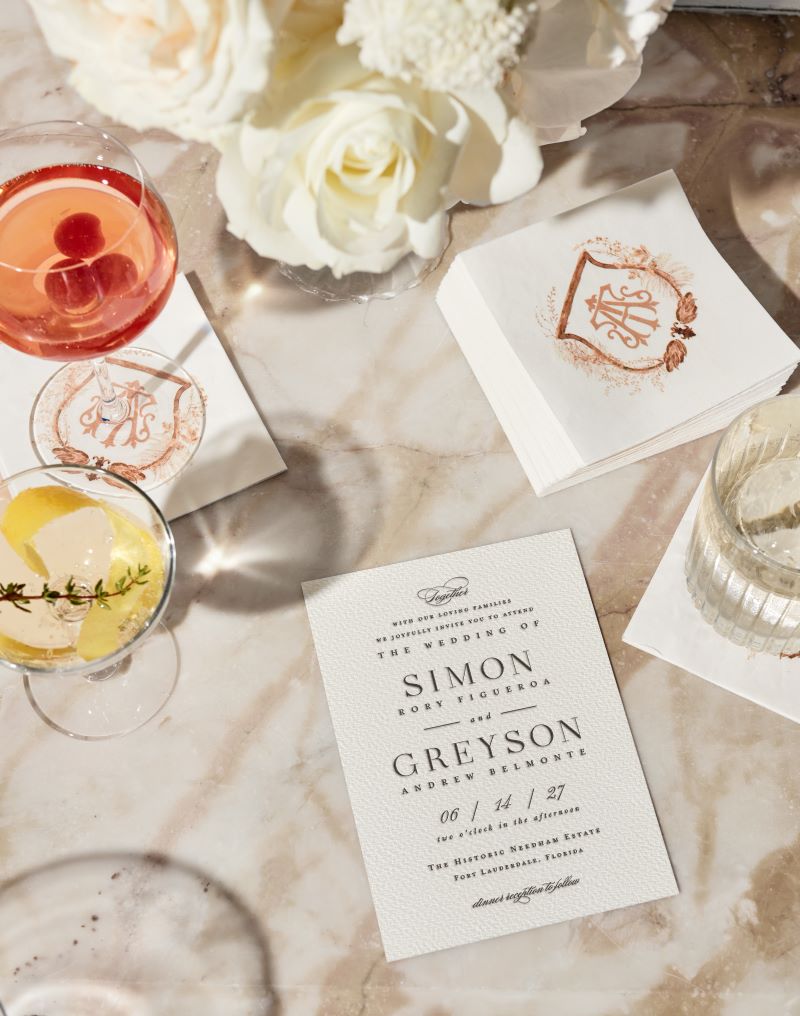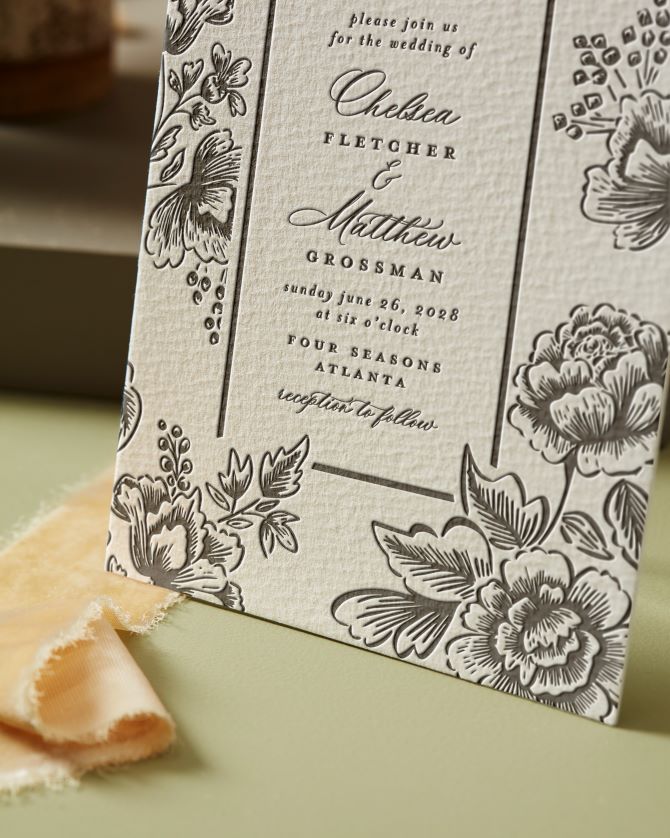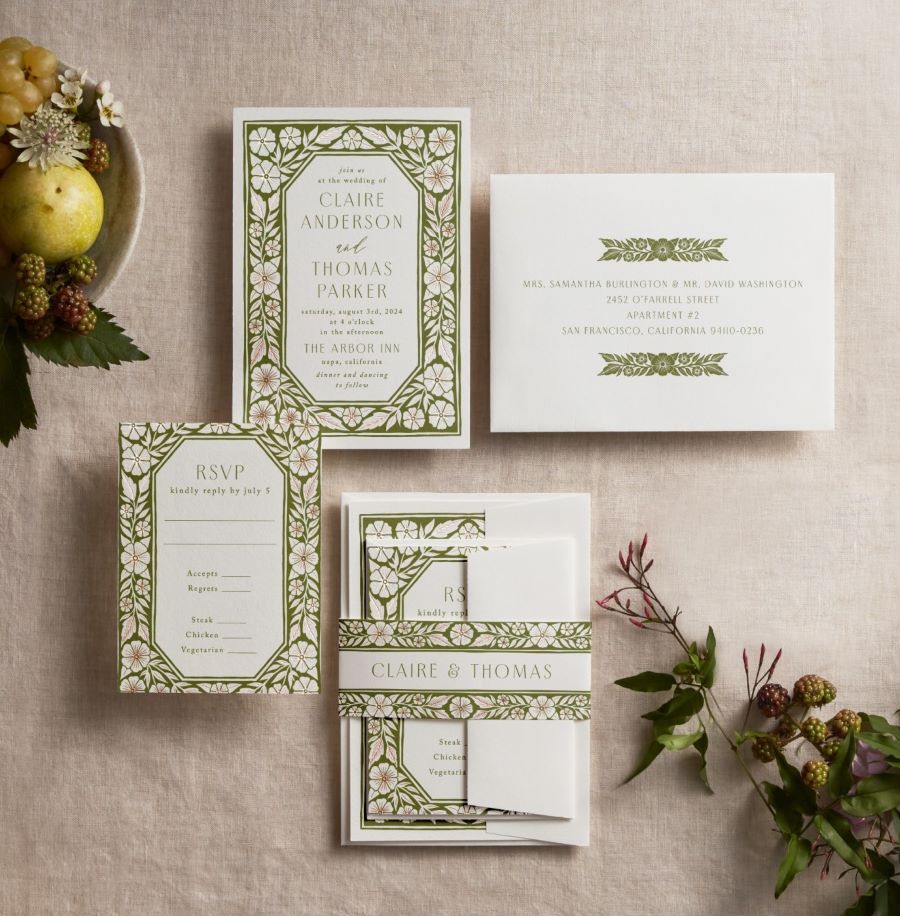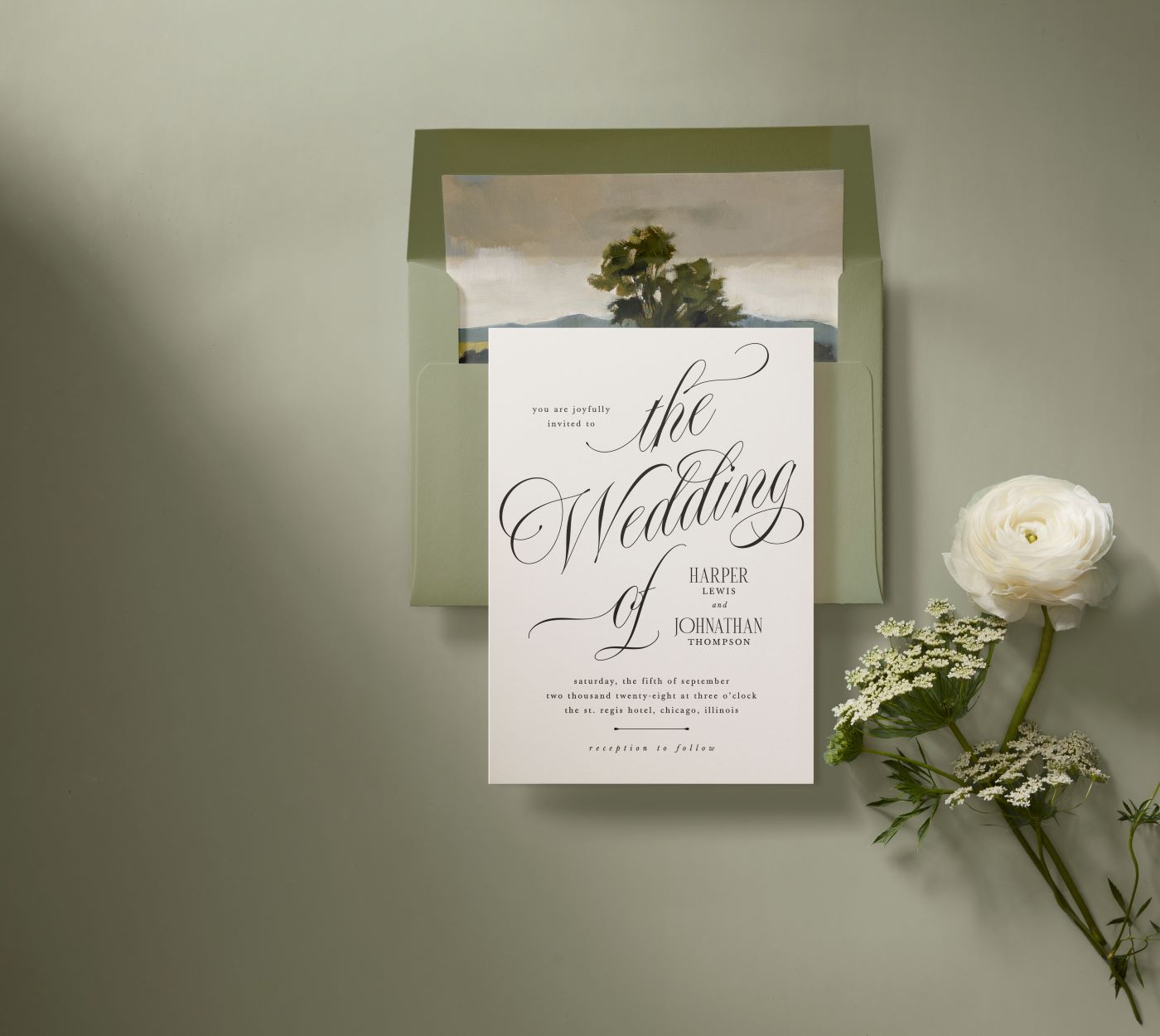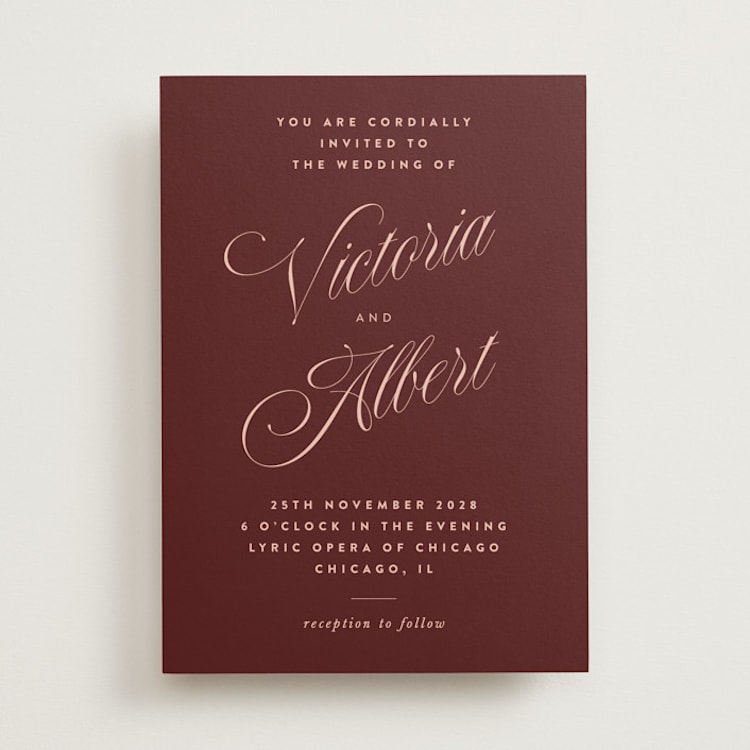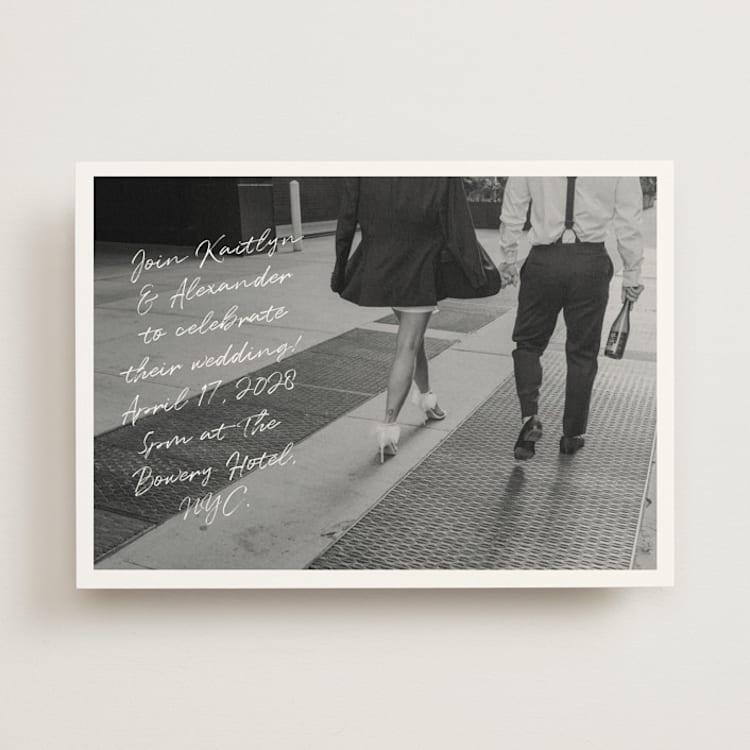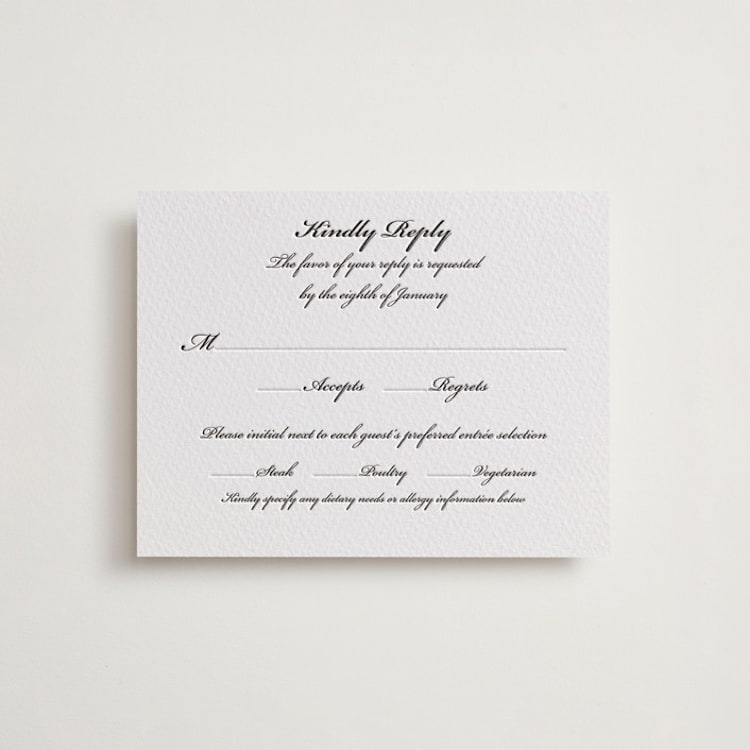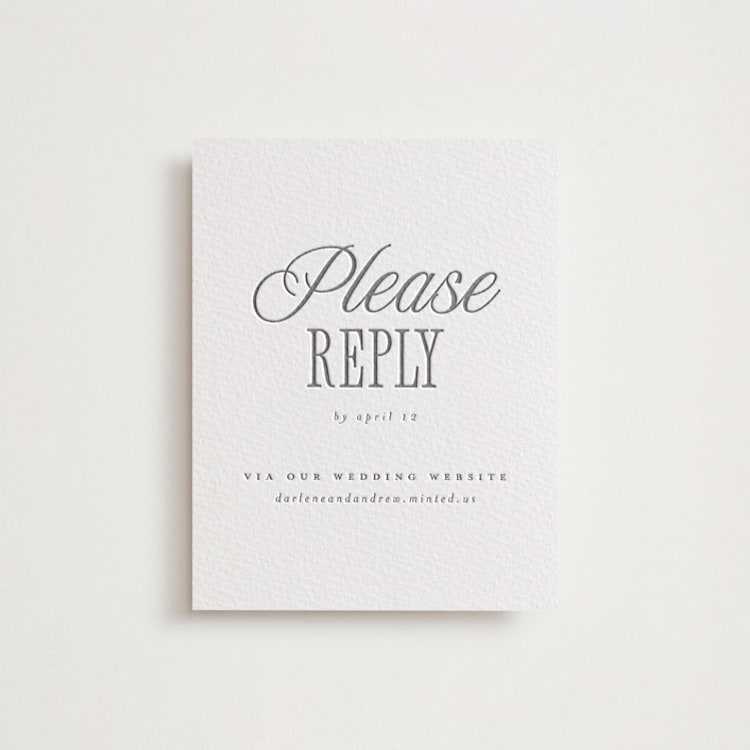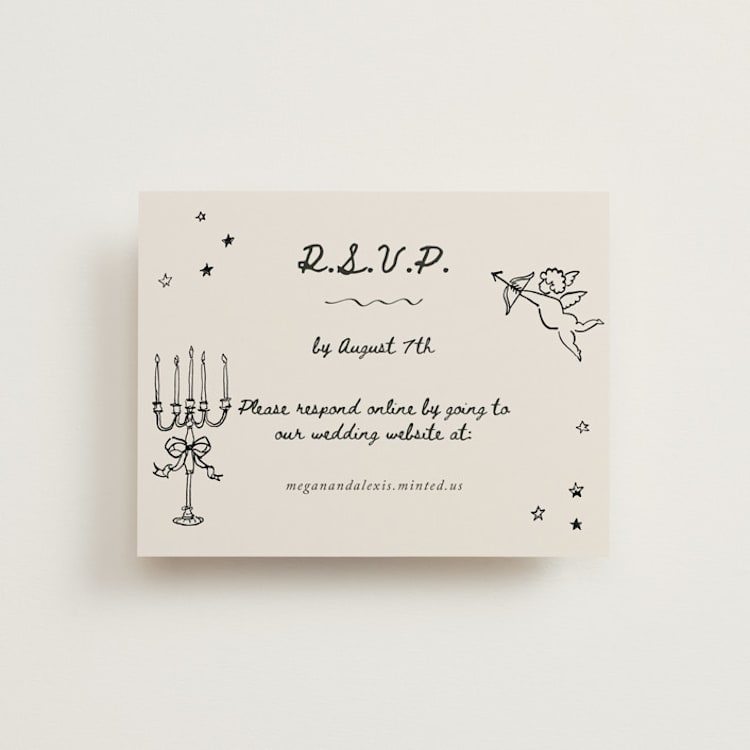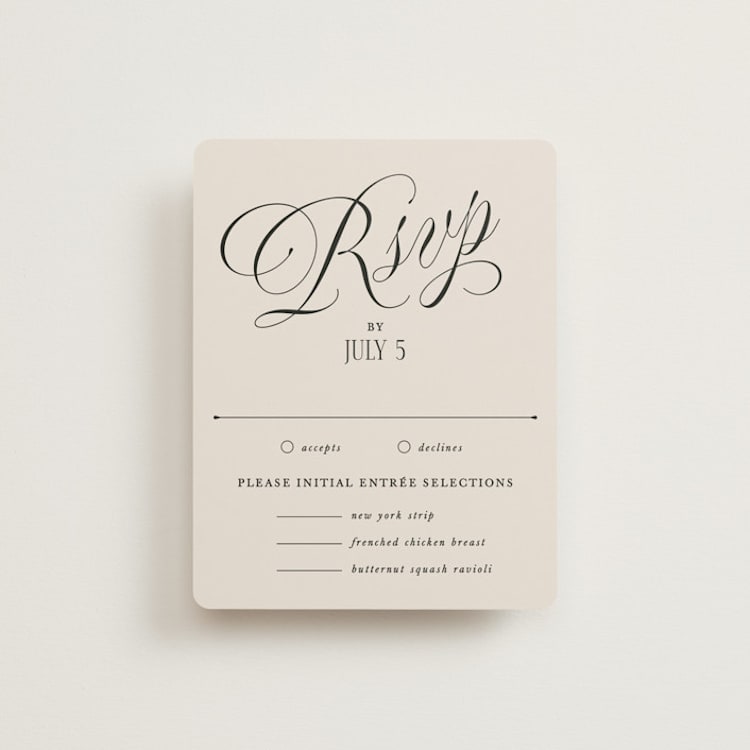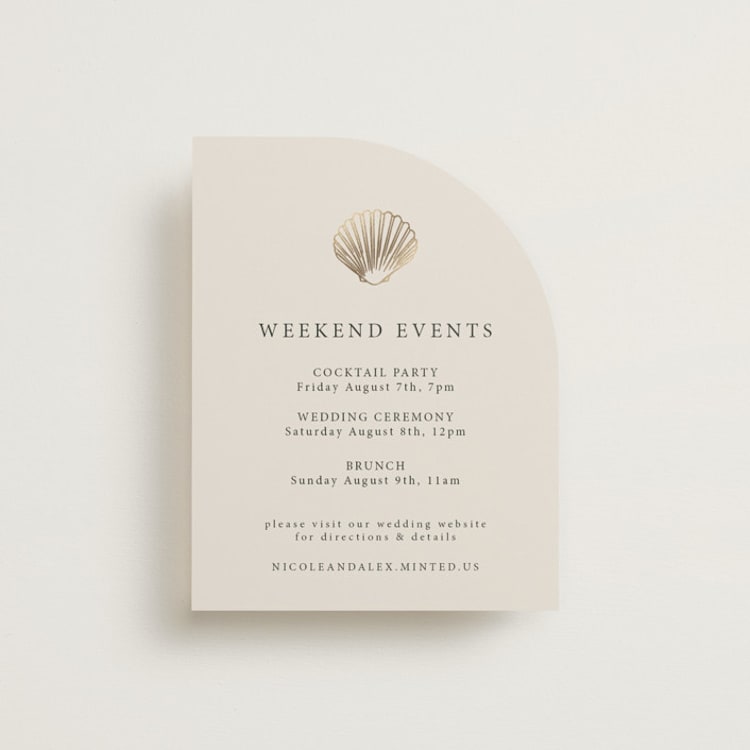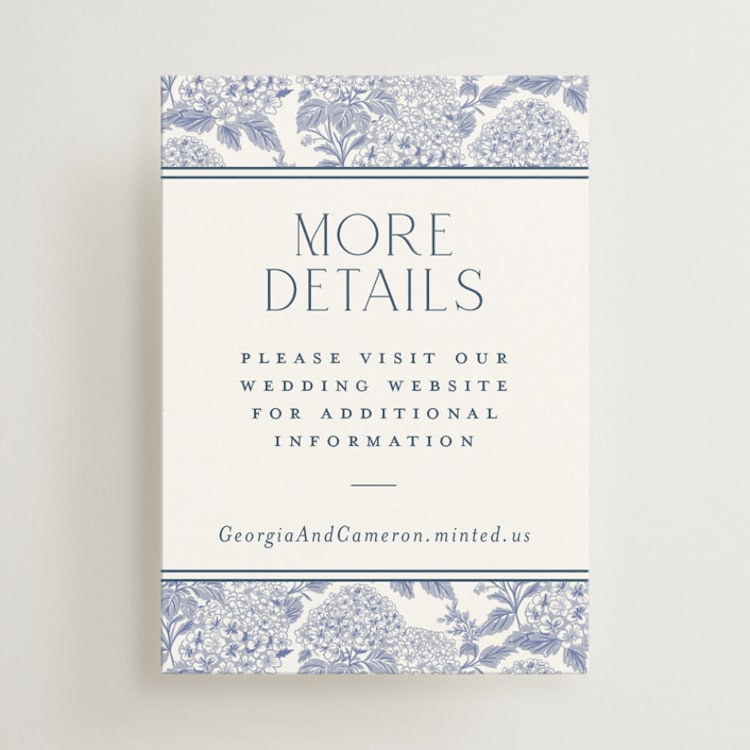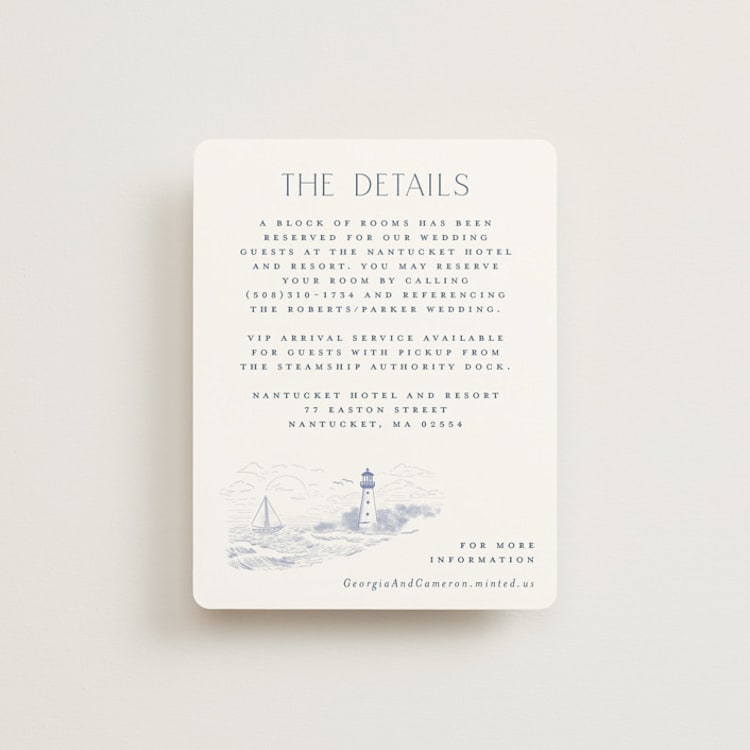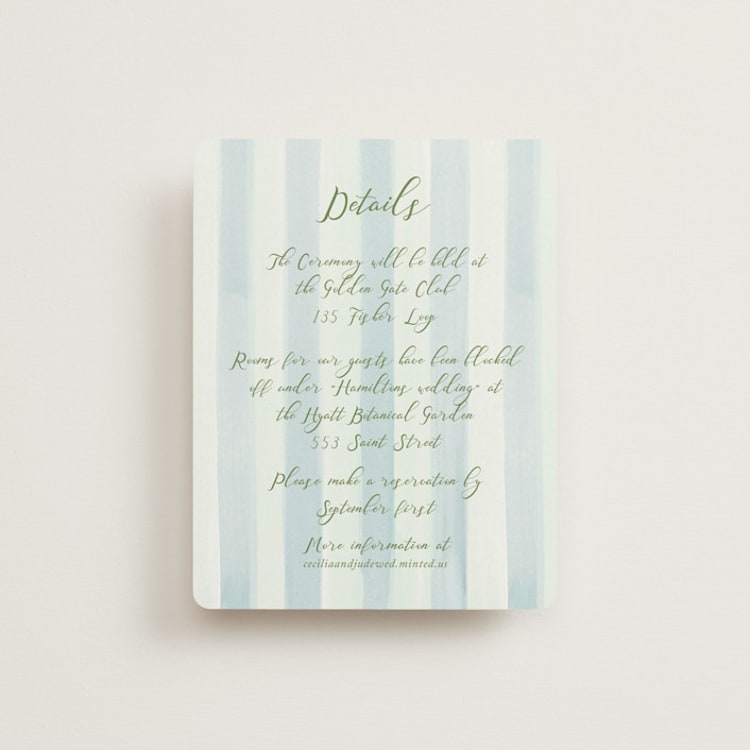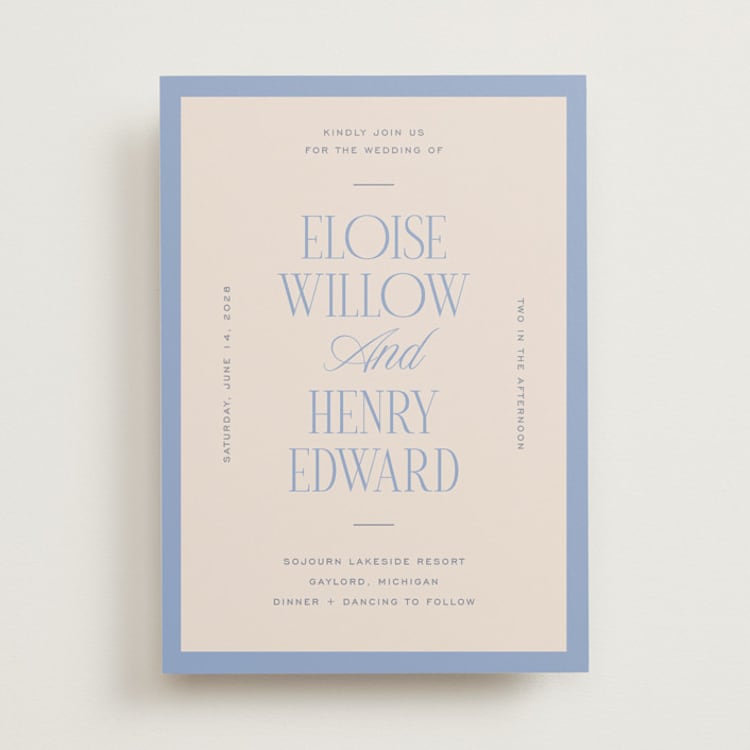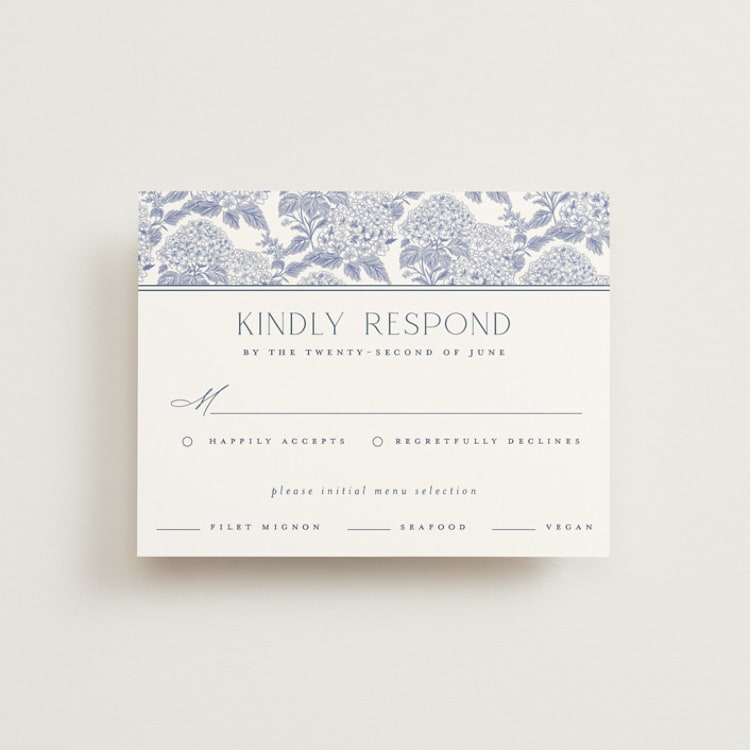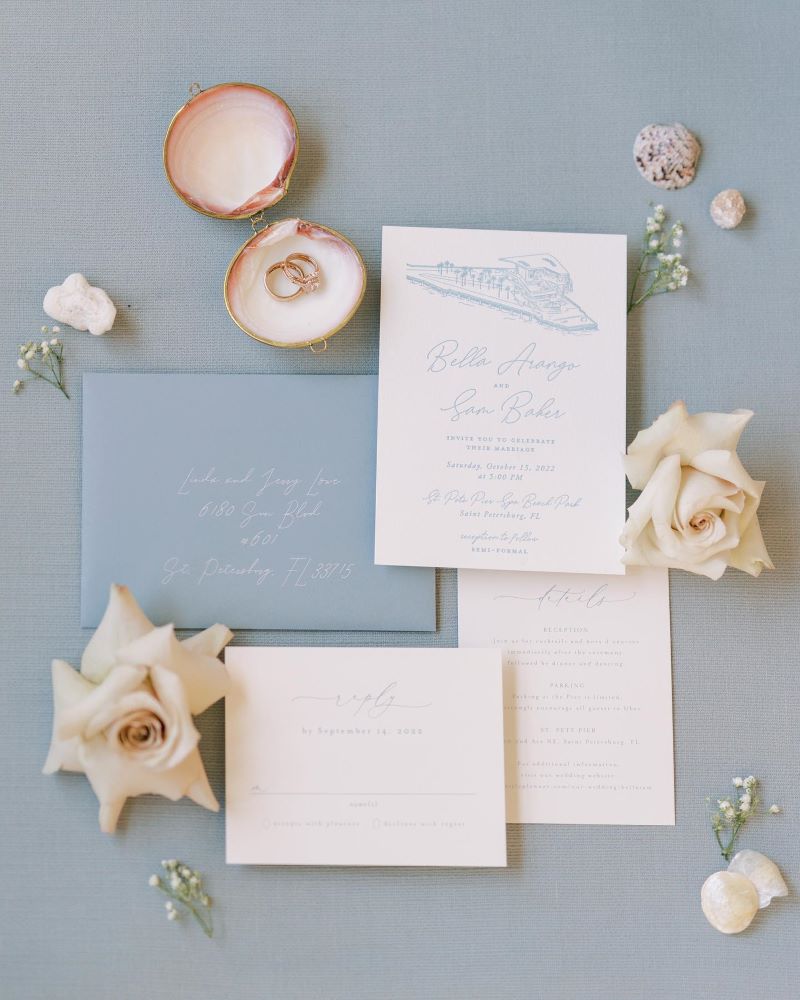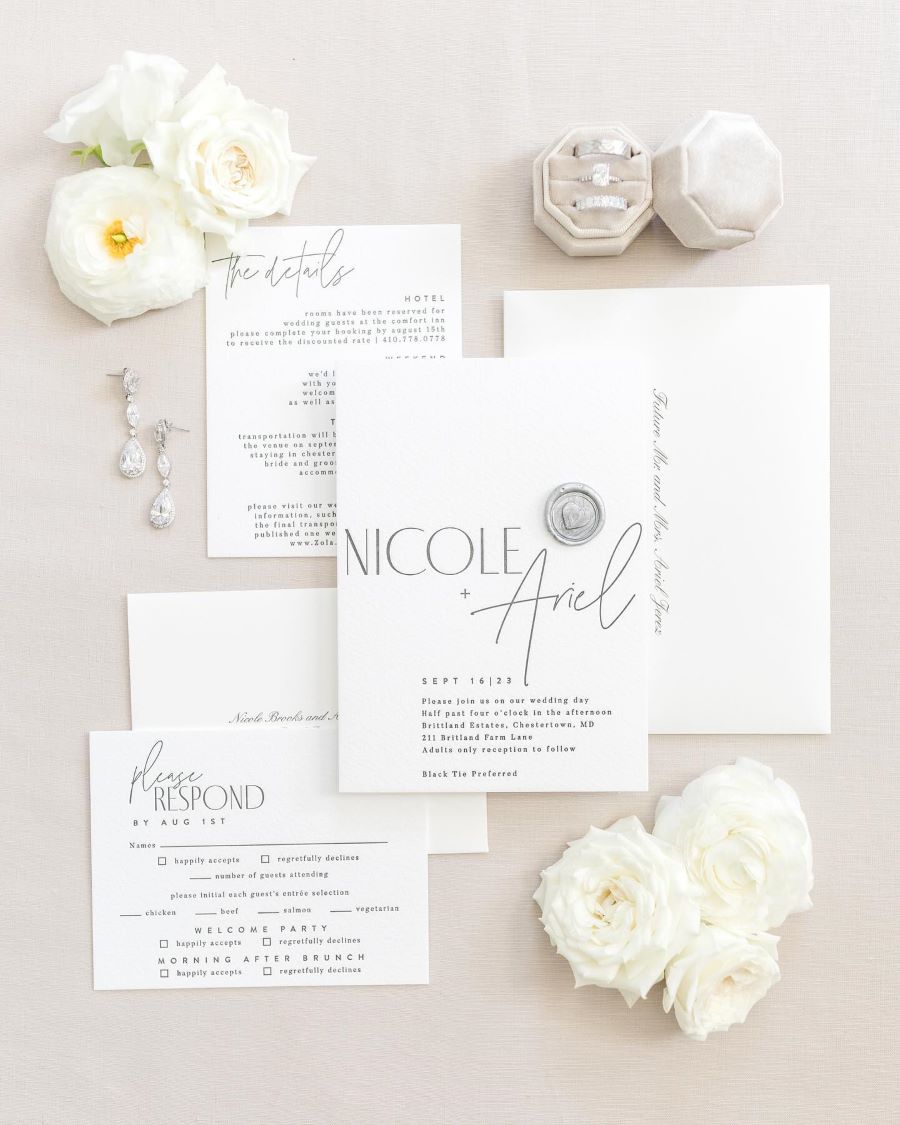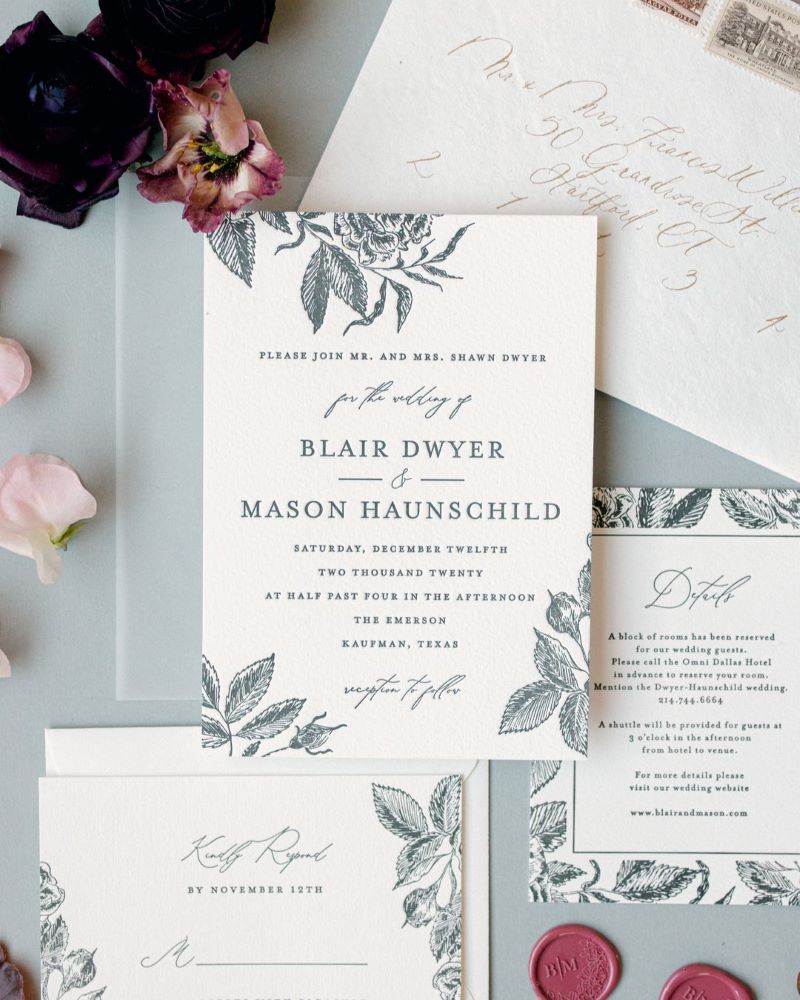Key takeaways:
- Wedding invitations should reflect a consistent level of formality, with tone and style matched across every piece. For example, if your invitation uses “honour,” your RSVP should use “favour.”
- Follow the format, but add your personal touch. The traditional structure of host line, request line, names, and details works for everyone, but adapt the wording to fit your unique situation.
- Details matter. Spell out numbers and times, capitalize correctly, and avoid mixing formal/informal language to ensure a polished final product.
So you’ve set a date, chosen a venue, and maybe even settled on a wedding invitation design. (If not, our sample kit can help.) Cheers to you! Admittedly, crafting the wording for your wedding invitation can be a little tricky. But fear not: You don’t have to be a wordsmith or Miss Manners to figure it out. We’ve compiled everything you need to know about exactly what to write on each line—and how to handle some of the etiquette situations you’re likely to encounter.
What to include
1. Host Line
Wedding invitation wording starts with a host line. Traditionally, the bride’s parents host, and so their names come first. But no matter who’s paying for the wedding, listing the names of both sets of parents is acceptable (and gracious). If the couple and their parents are contributing, you can opt for something like “Together with their parents” or “Together with their families.”
A common way to honor a deceased parent is alongside one of the couple’s names. Here’s an example: “Lauren Martinez, daughter of Marta Martinez,” or “Lauren Martinez, daughter of Robert Martinez and the late Marta Martinez.”
Host Line Wording Examples
One Set of Married Parents Hosting
Include the parents’ full names (with middle names for very formal weddings). If they have different last names, write “and” to join the two names.
- Mr. and Mrs. Christopher Timothy Williams (very formal; middle name is included)
- Mr. and Mrs. Christopher Williams (formal)
- Mr. and Mrs. Christopher and Sarah Williams (formal; includes both first names)
- Christopher and Sarah Williams (less formal)
One Set of Divorced Parents Hosting
Include the mother’s name first, followed by the father’s name. Do not use “and” to connect the two names; rather, each name should get its own separate line.
- Mrs. Rachel Arroyo
- Mr. Michael Nguyen
Both Sets of Parents Hosting
For different-sex couples, list the bride’s parents’ names at the top of the invite, then the groom’s parents’ names. For same-sex couples, list the names according to preference or in the order that looks best with the invitation design.
- Mr. and Mrs. Aaron Wong and Mr. and Mrs. Adam Hollis (formal)
- Aaron and Alisha Wong, together with Adam and Beatrice Hollis (less formal)
Military Titles
When one or both partners serve in the military, include their rank and branch of service in the host line.
- Colonel and Mrs. James Michael Smith
- Lieutenant Commander Sarah Johnson, United States Navy, and Mr. Robert Johnson
- Captain Maria Rodriguez, United States Army, and Mr. David Chen
Professional Titles
For couples with professional titles like doctors, judges, or other distinguished positions, include the appropriate designation.
- Dr. and Mrs. Christopher Williams
- Dr. Sarah Martinez and Dr. Michael Martinez
- The Honorable Judge Patricia Lee and Mr. Thomas Lee
Posthumous Parent Honoring
Beyond the basic example provided, here are additional ways to honor deceased parents in your wording.
- Lauren Martinez, daughter of Marta Martinez and the late Robert Martinez
- Michael Thompson, son of the late Margaret and Robert Thompson
- Together with Mrs. Helen Johnson and the late Mr. William Johnson, and Mr. and Mrs. David Chen
Step-Parent Inclusion
When step-parents have played significant roles in the couple's lives, you may want to acknowledge them in the host line.
- Together with their parents and step-parents
- Karen Wilson, together with Mark and Jennifer Wilson
- Mr. and Mrs. John Smith and Mr. and Mrs. Michael Jones (when both sets include step-parents)
Couple Is Hosting With Their Families
When the couple and both of their families are contributing to the cost of the wedding, many choose to add a line such as “Together with their families” as the host line.
- Together with their families
- Together with our families
- Together with their parents
Couple Is Hosting
If the couple is hosting the wedding themselves, you can skip the host line altogether or start the invitation wording with a warm and welcoming introduction, such as:
- With open hearts
- Together with full hearts
- With great joy
- With hearts full of love and joy
2. Request line
This is where you extend the invitation to attend your wedding, and you can use it to set the tone for your celebration. Here are a few more things to keep in mind:
- “The honor of your presence” is traditionally used to denote a religious service. Some couples opt to spell “honour” using the British spelling to evoke a more formal and traditional feel. (Note: If you’re using “honour” on the invitation, we recommend matching it with “favour,” as in “favour of your reply,” on the RSVP card.)
- “The pleasure of your company” (or variations on this) is used to denote a non-religious ceremony locale.
Request line wording examples
- request the honor of your presence
- request the pleasure of your company
- invite you to celebrate with them
- would love for you to join them
Tone Variations
Beyond traditional formal phrasing, you can set different tones that match your celebration's personality.
Playful/Casual Wording
- invite you to party with them
- want you there to celebrate
- invite you to join the fun
- request your presence for the celebration of a lifetime
Romantic/Poetic Wording
- invite you to witness a love story come true
- request your presence as two hearts become one
- invite you to share in a moment written in the stars
- request your presence for a celebration of eternal love
Cultural/Religious Specific Wording
Different faith traditions and cultural backgrounds have specific terminology that can be incorporated into your request line.
Jewish Ceremonies
- invite you with B'Simcha (With Joy)
- together with Hashem's blessings, invite you
- request your presence and blessings
Hindu Ceremonies
- request your gracious presence
- by the grace of Lord Ganesha, invite you
- request your blessings and presence
- invite you to witness and bless
Catholic Ceremonies
- request the honor of your presence
- invite you to witness and celebrate
- request your presence for this blessed occasion
- invite you to share in God's blessing
Interfaith Ceremonies
- invite you to celebrate with open hearts
- request your presence as we unite our traditions
- invite you to witness our blessed union
- request your presence for our celebration of faith and love
3. Action line
Here, you’re outlining what you are inviting people to share in (cue the confetti). There are many ways to word this, depending on who’s hosting and how formal your wedding will be.
Action line wording examples
- at the marriage of their daughter (if the bride’s parents are hosting)
- at the marriage of their children (if both sets of parents are hosting)
- at the celebration of their union (if the couple is hosting)
- as they say “I do!”
- in celebration of their marriage
Modern Relationship Wording
Contemporary relationships may call for updated action line phrasing that better reflects your unique situation.
Long-Term Partnerships
- as they celebrate their commitment
- as they affirm their love and partnership
- to witness their union of hearts
Second Marriages
- as they begin their new journey together
- in celebration of their marriage
- as they joyfully unite their families
Elopement Announcements
- for a celebration of our union
- to celebrate our marriage
- as we celebrate saying "I do!"
Commitment Ceremonies
- as they exchange vows of commitment
- as they pledge their love and devotion
- to witness their promise of forever
4. Couples’ Names
This one might seem easy—until you start thinking about the nitty-gritty details. Whose name goes first? Do you have to include last names? What about middle names? Though there really are no right or wrong answers—do whatever feels most comfortable to you both—here are a few suggestions:
- For different-sex couples, the bride’s name typically goes first, followed by the groom’s name. If the bride’s parents’ names are listed at the top, the bride’s name can just be her first and middle name (without last name). In that case, the groom’s name is either listed in full, or his first and middle names are listed followed by the line “Son of Mr. & Mrs. Stephen Wong.”
- For same-sex couples, you can list the names in alphabetical order by last name or based on what looks best with the design of the invitation.
- For a less formal feel, you may opt to list first names only.
5. Date & Time
Traditionally, the date and time should be spelled out in full. For example, if your ceremony is on September 15, 2027, at 4:30 p.m., the wording should read, “Saturday, the fifteenth of September, two thousand twenty-seven, at half after four in the afternoon.” The day of the week and the month should be capitalized, and the year should be lowercase. There is no “and” when spelling out the year.
The time of day should be spelled out as “four o’clock” or “half after four o’clock.” Evening begins at five o’clock. From noon until four o’clock is considered afternoon.
Date & Time Wording Examples
- 4:00 p.m. can be spelled out as:
- four o’clock (traditional)
- four o’clock in the afternoon (also acceptable)
- 4:00 p.m. (informal)
- 4:00 p.m. in the afternoon (informal)
- 4:30 p.m. can be spelled out as:
- half after four o’clock (traditional)
- half past four o’clock (also acceptable)
- four-thirty in the afternoon (also acceptable)
- 4:30 p.m. (informal)
6. Location
This is where you'll let guests know exactly where to find you on your big day. The location line provides essential venue information while maintaining the elegant flow of your invitation. Keep in mind that the level of detail you include should match the formality of your invitation and the familiarity your guests have with the area.
- List the ceremony venue as follows: “Venue Name” on one line, “City, State” on the following line. For formal weddings, the state name is usually spelled out.
- The venue’s street address is traditionally not included unless the venue is a private residence.
- Zip codes are not usually included.
7. Reception line
If the reception will be at the same location as the ceremony, you can simply say, “Reception to follow” or “Dinner and dancing to follow.” If the reception is at a different location, you can list the venue on the following line or on a separate insert card, called a reception card. And if you’re not serving a full meal, this would be a great place to let guests know by saying something like, “Join us after the ceremony for cocktails, hors d'oeuvres, and dancing.”
Reception line wording examples
- Reception to follow
- Reception immediately following the ceremony
- Dinner and dancing to follow
- Cake, punch, and merriment to follow (if you’re not serving a full meal)
- Feasting and merriment to follow
- Dining, dancing, and happily ever after to follow
Reception-Specific Wording Variations
The style of reception you're hosting can influence your wording choices beyond the basic examples.
Brunch Receptions
- Join us for brunch and celebration following the ceremony
- Morning ceremony, midday merriment to follow
- Brunch, bubbles, and bliss to follow
- Celebrate with mimosas and matrimony
Cocktail-Only Receptions
- Cocktails, hors d'oeuvres, and celebration to follow
- Join us for drinks and dancing under the stars
- Sip, savor, and celebrate with us
- Cocktail hour extends into the evening
Outdoor/Casual Receptions
- Lawn games and laughter to follow
- Barbecue and dancing under the open sky
- Garden party celebration to follow
- Casual celebration in the countryside to follow
Adults-Only Wording
- Adult celebration to follow
- Join us for an evening of dinner and dancing (adult reception)
- We respectfully request that this be an adults-only celebration
- Although we love all the children in our lives, this will be an adult-only event
Other Considerations
Dress Code
This is optional, but it can be helpful for guests. One exception: If your wedding is black tie, you must include that on the invitation. If you don’t include wedding attire information on the invitation, guests will infer it based on the formality of the wedding invitation itself. For example, if the invitation is formal, guests will likely anticipate a formal affair. A simpler invite suggests wedding attire that leans more casual. The dress code line should be listed on a line following the reception location.
Dress Code Wording Examples
- Black-tie (tuxedos and floor-length gowns)
- Formal attire (suits and dresses)
- Cocktail attire (suits or dress shirts with ties and cocktail dresses)
- Beach-casual (long- or short-sleeve shirts with pants or shorts, sundresses, and sandals)
Wedding Website
Typically, you don’t print your wedding website on the main invitation card; rather, you should list it on the reception card or an additional information card. It’s also a good idea to have your wedding website URL (or the QR code) on your save the date.
Wording Do's and Don'ts
Getting the wording right involves more than just following examples. Keep these essential guidelines in mind.
DO:
- Use consistent verb tenses throughout ("request," "invite," "celebrate")
- Include pronunciation guides for difficult names: Xiomara Nguyen (pronounced "See-oh-MAH-rah WIN")
- Spell out numbers in formal invitations: "two thousand twenty-seven" not "2027"
- Ensure each line makes grammatical sense as a complete thought
DON'T:
- Mix formal and informal language styles in the same invitation
- Use "and guest" when you can get the actual name of a guest’s significant other or date
- Include gift registries, monetary requests, or gift information
- Abbreviate unnecessarily in formal invitations: write "Street" not "St."
- Use ampersands (&) in traditional and very formal invitations
Common Wording Mistakes to Avoid
Honour/Honor Consistency Error
Wrong: "honour of your presence" with "favor of your reply"
Right: "honour of your presence" with "favour of your reply"
Time Format Mixing
Wrong: "Saturday, September fifteenth at 4:30 PM"
Right: "Saturday, the fifteenth of September at half after four in the afternoon"
Capitalization Inconsistency
Wrong: "saturday, The Fifteenth of September"
Right: "Saturday, the fifteenth of September"
Awkward Multiple Host Phrasing
Wrong: "Mr. and Mrs. Smith and Mr. and Mrs. Jones and the couple request..."
Right: "Together with their parents, Mr. and Mrs. Smith and Mr. and Mrs. Jones, [Couple] request..."
Complete Your Suite
Wondering what else to send with your wedding invitation? Read on for exactly what you'll need to include. And once you’ve finalized your invitation wording, think about presentation details like the envelope, which can help set the tone from the moment your guests receive it.
RSVP Cards
Good news! Wording the RSVP card (also called the reply card or response card) is a simpler task than the invitation. Here’s what you’ll need to include:
RSVP date: The first piece of information on the card is the reply-by date, which is typically three to four weeks before the wedding. This will give you enough time to get a final head count to the caterer (one week before) and to finalize your seating chart.
Remember to keep the wording consistent with the invitation. For example, “the favor of a reply” typically matches the invitation wording “the honor of your presence.” For less formal wedding invitation wording, such as “request the pleasure of your company,” the RSVP wording would typically be “Kindly reply by” or “Kindly respond by.”
Guest(s) names: Next is a line for guests to write their names, along with checkboxes for accepting or declining the invitation.
Most traditional weddings use the “M” line to indicate the place where guests will write in their names. The “M” itself is meant to designate the first letter of the formal salutation (Mr., Mrs., Miss, or Ms.) that the guest would write along with their name(s). For less formal celebrations, we suggest the more straightforward “Name(s)” instead.
Dietary Restrictions: If you're serving a meal, it's helpful to know about food allergies or dietary preferences ahead of time. You can include a simple line such as "Please inform us of any dietary restrictions" or "Please note any food allergies or dietary needs." For a more formal approach, try "Special dietary requirements: _______________."
Song Requests: You can get creative with how you ask guests to help build your playlist. Consider variations like "Help us rock the dance floor! Song suggestion: _______________," "Request a song that will get you dancing: _______________," or "What song will bring you to the dance floor? _______________."
Transportation Needs: If you're providing shuttle service or transportation, make it easy for guests to let you know their needs. Simple options include "Will you need transportation to the venue? _____ Yes _____ No," "Shuttle service available - please indicate if needed," or "Transportation will be provided - please confirm if you'll use it."
Multiple Event RSVPs: For wedding weekend celebrations with multiple events, you'll need to track attendance for each occasion. You can format this as individual lines like "Welcome Dinner (Friday): _____ Will attend _____ Will not attend" for each event, or use a checkbox format such as "Please mark all events you plan to attend: □ Rehearsal Dinner □ Wedding Ceremony □ Reception □ Sunday Brunch."
Reception Cards
If the ceremony and reception are held at the same venue, include the line “Reception to follow” at the bottom of the invitation. However, if the reception is held at a different location, it should be treated as a separate event—include a separate reception card with the event details as part of the invitation suite.
Activity Card
Activity cards can be very helpful if your wedding has multiple events taking place during the wedding weekend. List all of the festivities open to guests in chronological order. Our complete guide on wedding detail cards will be helpful, especially when you have a lot of information to share with your guests.
If you choose not to include the activity card in your invitation suite, make sure you list this information on your wedding website.
Information Card
An information card can be enclosed with your wedding invitation if you’d like to provide any additional wedding details to guests: directions, transportation information, lodging suggestions, etc. Make sure to check out our guide on how to assemble your wedding invitation suite, especially if multiple enclosure cards are involved.
Wedding Invitation Wording FAQs
1. What is a host line, and what should it include?
The host line kicks off your invitation and names the person or family hosting the wedding. Traditionally, it names the bride’s parents, but you can also include both sets of parents or even a combination when the couple or both families are paying. It’s common to see lines like “Together with their families” or “Together with their parents.”
2. How do I word the request line?
The request line extends the invitation to guests. For religious ceremonies, you might say “request the honor of your presence,” while non-religious phrasing like “request the pleasure of your company” is common. Other variations include “invite you to celebrate with them” or “would love for you to join them.”
3. What recommendations are there for listing the couple’s names?
For different‑sex couples, the bride’s name typically comes first, and if the parents’ names appear at the top, the bride might be listed by her first and middle names only. For same‑sex couples, names can be ordered alphabetically or arranged in a way that best suits the design. In more casual styles, just first names may be used.
4. How should the date and time be formatted?
The date and time are traditionally spelled out—for example, “Saturday, the fifteenth of September, two thousand twenty-seven, at half after four in the afternoon.” Key points: always capitalize the day of the week and the month, spell out times like “four o’clock” or “half after four o’clock,” and note that formal wedding invitations omit “and” in the year.
5. What information does the RSVP card need?
The RSVP (or reply) card should include a clear deadline for responses (typically three to four weeks before the wedding). It should provide a space for the guest’s name, checkboxes for accepting or declining, and any additional details you want to gather (like meal preferences), ensuring consistency with the tone established in the main invitation.
6. How should reception details be presented?
If your reception follows the ceremony at the same venue, a line such as “Reception to follow” works well. If the reception is at a different location, you can include the venue address on a separate reception information card or an insert.
7. Is it necessary to include a dress code, and how should it be presented?
Including a dress code is optional, but it can be useful for guiding guests. For formal events, you might use “Black Tie” or “Formal Attire,” while for a more laid-back celebration, options like “Cocktail Attire” or “Beach-casual” can be specified. The dress code is usually placed after the reception location details on the invitation suite.
8. What other invitation suite cards should I consider including?
In addition to the main invitation, many couples include RSVP cards, reception cards (if the reception venue differs), activity cards outlining additional events, and information cards that provide details like directions, transportation, or lodging suggestions.
Your Perfect Wedding Invitation Awaits
Now that you have all the tools and examples you need, it's time to bring your wedding invitation vision to life. From traditional elegance to modern flair, the right words will set the perfect tone for your celebration. Remember, the most beautiful invitations are those that authentically reflect your love story and the joy you want to share with family and friends. Take your time, choose words that feel true to you, and enjoy this special part of your wedding planning journey.



